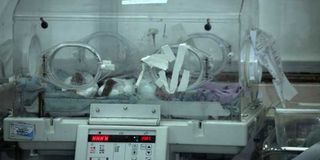Let’s make preterm babies live and thrive

Babies in an Incubator at Kenyatta National Hospital in this picture taken on July 1, 2017. PHOTO | EVANS HABIL | NATION MEDIA GROUP
What you need to know:
- In humans, the infant is carried skin-to-skin by the mother and other family members can help.
- Already, KMC has been introduced in 20 counties and hundreds of health workers trained.
It would have been a time of joy when Anne and John Simiyu were blessed with twin boys.
However, born five weeks to term, the infants’ survival was hanging by a thread.
They also faced a threat at home, where relatives believed that it was not only a bad omen to have twins, but to have them born before time, and as the firstborns.
A verdict was quickly reached that one of them had to die.
INFANTS
Today, Ann owes the lives of her children to her husband, who took an active interest in the infants’ welfare, and nurse Gladys Wanjala, who introduced the couple to a natural means of taking care of infants born below the ideal birth weight of two-and-a-half kilogrammes.
The twins, born at Siboti Health Centre in Bungoma County, weighed below one-and-a-half kilogrammes. Ms Wanjala first thought of referring them to Bungoma County Referral Hospital, where the babies would be put in incubators.
“But the mother was in no condition to travel. I introduced them to Kangaroo Mother Care, and the couple embraced it.”
Kangaroo Mother Care (KMC), first practised in Colombia in 1978, is inspired by the marsupials that care for their prematurely born young ones in a thermal-heated pouch.
In humans, the infant is carried skin-to-skin by the mother and other family members can help.
“When I put the baby on KMC, I could feel it breathing. Sometimes when one baby was left on the cot, it looked like it was dead but when I put both of them on kangaroo they became well,” says Anne.
DISCHARGED
Four weeks later, the babies were discharged, having gained over 500 grams each. In Kenya, more than 180,000 babies are born premature every year and nearly 15,000 die.
Kenya is among the 15 countries with the highest number of preterm babies. Globally, about 15 million babies are born too soon each year.
Preterm birth, defined by the World Health Organisation (WHO) as all births before 37 weeks of gestation, is a leading cause of death among children under five in Kenya and in the world.
Preterm babies are vulnerable and thousands can be saved if they receive extra care. Managing severely premature babies involves intensive care, requiring specialist skills and equipment such as incubators and respirators.
Often, incubators are insufficient and babies have to share them, leading to cross-infection. Fortunately, a majority of preterm babies are moderately premature and can be saved with simple low-cost solutions that do not require incubators.
The Health ministry is working with partners such as Save the Children to provide KMC to every health facility.
Already, KMC has been introduced in 20 counties and hundreds of health workers trained.
MYTHS
In Bungoma County, where Save the Children is funded by the UK Government under the County Innovation Challenge Fund (CICF), communities have embraced it, dispelling myths that spelt doom for premature babies.
Recent studies have shown that the lives of tens of thousands of premature babies could be saved by simply delaying clamping the umbilical cord by a minute.
There is also evidence that donated human milk could save premature babies where a mother dies or is not in a position to breastfeed.
The CICF plans to invest in the first human milk bank in Kenya. Also, draft National Human Milking Guidelines will be launched soon.
November 17, the World Prematurity Day is meant to increase awareness about preterm births, deaths and disabilities and simple and cost-effective measures that could prevent them.
This year’s theme was ‘Let them thrive! - Respectful care for the Smallest’. Let’s promote actions protect the right to quality health care for families, including vulnerable preterm babies.
Mr Karuga is the technical fund manager, County Innovation Challenge Fund.kkaruga@manikenya. enya.com, and Ms Nyamamu, the communications manager, Save the Children. [email protected]




